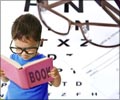Every class of 30 children had one or two children with at least one brain-related vision problem, said the researchers.

‘Brain-related vision problems include difficulties with moving the eyes, seeing things in the space around (visual field) and recognizing objects accurately and quickly.’





The brain is just as important as the eyes when it comes to seeing, and many vision problems are caused by areas of the brain that are needed for sight not working properly and cannot be resolved by wearing glasses. Brain-related vision problems include difficulties with moving the eyes, seeing things in the space around (visual field) and recognizing objects accurately and quickly.While eye chart tests check how well a person can see the details of a letter or symbol from a specific distance, these visual acuity diagnostic assessments miss many children with CVI, whose acuity is normal or near-normal (they can read down a chart). The study, funded by the National Institute for Health Research (NIHR), investigated how many school-aged children may have undiagnosed brain-related vision problems.
Researchers from University of Bristol Medical School collected information about 2,298 children aged five to 11-years across 12 schools using teacher and parent questionnaires. They invited over ten per cent of the children (262 pupils) for a detailed assessment using validated tests to identify children with brain-related visual problems suggestive of CVI.
The team found that based on their results, on average, every class of 30 children, would have one or two children with at least one brain-related vision problem. They found no single problem was most common: the difficulties observed included problems with eye movements, visual field, recognition of objects and seeing things in clutter.
The team also found that children who were struggling with their learning and were already being given extra help at school, were more likely to have brain-related vision problems: four in every ten children with support for special educational needs had one or more brain-related vision problems, whilst for all children it was only about three in 100.
Advertisement
The authors recommend in future that detailed vision checking of all children who need extra support at school, as well as the existing pediatrician and educational psychology assessments, could improve outcomes for children.
Source-Eurekalert










